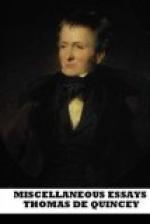Thus, gentlemen, I have traced the connection between philosophy and our art, until insensibly I find that I have wandered into our own era. This I shall not take any pains to characterize apart from that which preceded it, for, in fact, they have no distinct character. The seventeenth and eighteenth centuries, together with so much of the nineteenth as we have yet seen, jointly compose the Augustan age of murder. The finest work of the seventeenth century is, unquestionably, the murder of Sir Edmondbury Godfrey, which has my entire approbation. At the same time, it must be observed, that the quantity of murder was not great in this century, at least amongst our own artists; which, perhaps, is attributable to the want of enlightened patronage. Sint Maecenates, non deerunt, Flacce, Marones. Consulting Grant’s “Observations on the Bills of Mortality,” (4th edition, Oxford, 1665,) I find, that out of 229,250, who died in London during one period of twenty years in the seventeenth century, not more than eighty-six were murdered; that is, about four three-tenths per annum. A small number this, gentlemen, to found an academy upon; and certainly, where the quantity is so small, we have a right to expect that the quality should be first-rate. Perhaps it was; yet, still I am of opinion that the best artist in this century was not equal to the best in that which followed. For instance, however praiseworthy the case of Sir Edmondbury Godfrey may be (and nobody can be more sensible of its merits than I am), still I cannot consent to place it on a level with that of Mrs. Ruscombe of Bristol, either as to originality of design, or boldness and breadth of style. This good lady’s murder took place early in the reign of George III., a reign which was notoriously favorable to the arts generally. She lived in College Green, with a single maid-servant, neither of them having any pretension to the notice of history but what they derived from the great artist whose workmanship I am recording. One fine morning, when all Bristol was alive and in motion, some suspicion arising, the neighbors forced an entrance into the house, and found Mrs. Ruscombe murdered in her bed-room, and the servant murdered on the stairs: this was at noon; and, not more than two hours before, both mistress and servant had been seen alive. To the best of my remembrance, this was in 1764; upwards of sixty years, therefore, have now elapsed, and yet the artist is still undiscovered. The suspicions of posterity have settled upon two pretenders—a baker and a chimney-sweeper. But posterity is wrong; no unpractised artist could have conceived so bold an idea as that of a noon-day murder in the heart of a great city. It was no obscure baker, gentlemen, or anonymous chimney-sweeper, be assured, that executed this work. I know who it was. (Here there was a general buzz, which at length broke out into open applause; upon which the lecturer blushed, and went on with much earnestness.) For Heaven’s sake,




